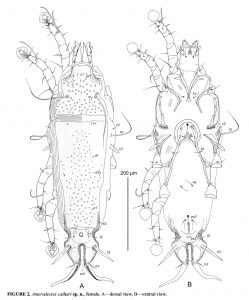Biologists describe eight new species from the Georgia Southern Statesboro Campus
 Eight new species of feather mites that have never before been described anywhere have been identified on the Georgia Southern University campus in Statesboro. How do eight unknown species go undetected for so long? They are very small and live in a surprising location.
Eight new species of feather mites that have never before been described anywhere have been identified on the Georgia Southern University campus in Statesboro. How do eight unknown species go undetected for so long? They are very small and live in a surprising location.
The new species are feather mites of the genus Amerodectes, and they live only on the feathers of birds. These tiny mites – an adult is only a little larger than the period at the end of this sentence – cling to the feathers of birds. They feed on oil and other body secretions of their hosts. Once the discovery was made, Sergey Mironov, Ph.D., of the Russian Academy of Sciences and an international authority on feather mites, along with professor Ray Chandler, Ph.D., of the Department of Biology at Georgia Southern, collaborated in order to describe the species in a recent issue of the journal Zootaxa, making their findings available to all scientists.
The new mites from the Georgia Southern Statesboro Campus were collected from the feathers of common resident and migratory songbirds: Swainson’s Thrush, Wood Thrush, Worm-eating Warbler, Ovenbird, Common Yellowthroat, Chipping Sparrow, House Finch and Painted Bunting.
“The rarity with which new species are found varies with the taxonomic group,” explained Chandler. “New birds and mammals are rarely found. New mites, ants, insects, etc. are described more often; however, in a well-studied area like the U.S., especially on a college campus full of students, this is a rare event.” said Chandler.
When deceased birds are found on campus, quite often following a bird’s collision with large reflective surfaces on buildings, faculty in the Department of Biology, under a permit from the U.S. Fish and Wildlife Service, carefully preserve them and collect parasites, tissue samples and other potentially useful data. The goal is to gather as much data from each individual bird as possible, which can also then be shared with visiting scientists like Mironov.
“Although birds dying as a result of collisions with surfaces such as windows is a major issue everywhere, at Georgia Southern we are doing our best to make as much use of these specimens as possible,” said Chandler. “We never anticipated finding so many new species.”
“That common birds on our campus carry undescribed species is a good indication that we have a long way to go in describing the Earth’s biodiversity,” explained Chandler. “You can imagine how many unknown species live in remote tropical forests.”
Mironov will be visiting Georgia Southern again in May, and there is the possibility that more hidden biodiversity will be found on our campus. A copy of the publication describing the new species can be found online.
Georgia Southern University, a public Carnegie Doctoral/Research institution founded in 1906, offers 142 degree programs serving more than 27,000 students through nine colleges on three campuses in Statesboro, Savannah, Hinesville and online instruction. A leader in higher education in southeast Georgia, the University provides a diverse student population with expert faculty, world-class scholarship and hands-on learning opportunities. Georgia Southern creates lifelong learners who serve as responsible scholars, leaders and stewards in their communities. Visit GeorgiaSouthern.edu.
Posted in Press Releases, University Homepage

